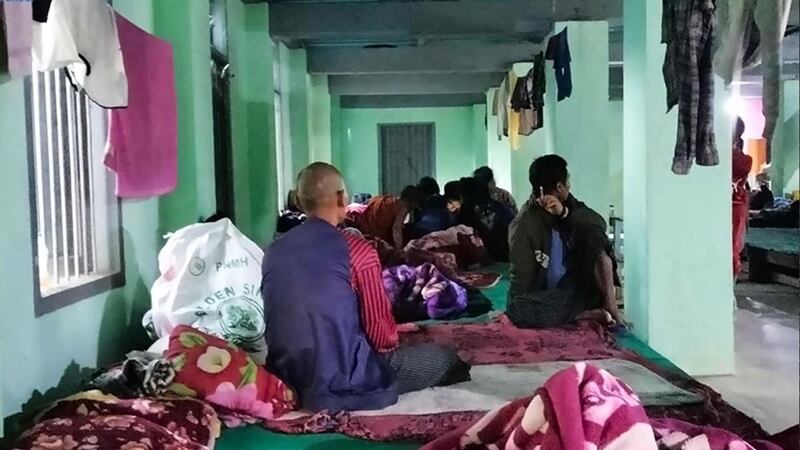Junta troops abducted around 20 civilians to use as human shields from a village in northern Myanmar’s Kachin state and are heavily bombarding the area as part of raids that have forced some 20,000 people to flee their homes since last week, residents said Wednesday.
The raids on Hpakant township’s Hway Hkar village began on Jan. 9 and followed attacks by anti-junta People’s Defense Force paramilitaries on military outposts in the area three days earlier, sources told RFA Burmese.
A resident of Hway Hkar who, like others interviewed for this report, spoke on condition of anonymity citing security concerns, said the military retaliated with airstrikes and artillery before junta troops stormed the village and seized around 20 male residents who he said earn a living as scavengers at nearby jade mines.
“When you leave Hway Hkar, there is a place called a ‘strategic hill’ where [the troops] are now stationed, and [detained] people are taken there,” he said. “They are local residents who live as scavengers. We haven’t been able to contact them.”
Since the initial raid, the military has been attacking areas near Hway Hkar every day with Russian-made Mi-35 combat helicopters and heavy artillery fired from the strategic hill, located around 11 kilometers (7 miles) outside of the village, residents said.
Another villager told RFA that the entire population of Hway Hkar and nearby Nam Tein had been forced to flee to take shelter from the attacks, as had residents from the surrounding area, leaving as many as 20,000 displaced.
“The fighting is taking place on the ground, but the junta is sending aircraft to drop bombs,” he said. “The entire village [of Hway Hkar] fled in panic … [The military] sent [planes] three times and dropped two or three bombs each time … in and around the village.”
Displaced people in need
More than 1,000 people who fled Hway Hkar have been taking temporary shelter in area religious buildings, said a person who is helping internally displaced persons, or IDPs, in Hseng Taung village.
“They have been taking shelter in churches and monasteries,” he said. “Residents [of Hseng Taung] who can afford it have been providing food for them.”
The aid worker said the IDPs include the ill and elderly, and that they need access to emergency health services.
Another resident of Hway Hkar told RFA that villagers fled with only what they could carry and now have no way to earn an income.
“This is a place where people scavenge to make a living – migrant workers across the country and laborers depend on the income from jade,” he said. “But now, it is difficult for scavengers to make ends meet and the prices of commodities are rising. We’re in deep trouble because fighting has resumed in Hpakant.”

Nay Phone Latt, the spokesman for Myanmar’s shadow National Unity Government, or NUG, said that the junta is increasingly using airstrikes and heavy artillery to terrify the public.
“While the [junta] is facing defeat on the ground, we are witnessing them kill people every day with airstrikes and shelling,” he said. “[The NUG is] continuously conducting campaigns – not only in the areas that we control, but also elsewhere – to keep people alert for danger at all times.”
Displaced residents of Hpakant told RFA that junta troops have blocked the Hpakant-Hway Hkar road since Jan. 6, so that even if fighting stops, they may not be able to return home.
Civilians targeted
Kachin Human Rights Watch, which has been monitoring and documenting human rights violations in Kachin state since the military’s Feb. 1, 2021, coup, said that the junta is committing its worst rights violations against civilians.
“The junta has not only conducted airstrikes on non-military targets, but on civilian areas such as villages and IDP camps,” the group recently said in a report. “This kind of thing should never occur and it’s a clear violation of international humanitarian laws.”
Calls by RFA to Sai Naing Naing Kyaw, the junta’s ethnic affairs minister for Sagaing region, seeking comment on the situation in Hpakant went unanswered Wednesday.
According to Myanmar’s 2014 census, more than 300,000 people live in Hpakant township, most of whom are migrant workers from around Myanmar and local ethnic residents.
The U.N. Office for the Coordination of Humanitarian Affairs announced on Dec. 15 that there are currently more than 2.5 million people displaced by conflict in Myanmar.
Translated by Htin Aung Kyaw. Edited by Joshua Lipes and Malcolm Foster.
